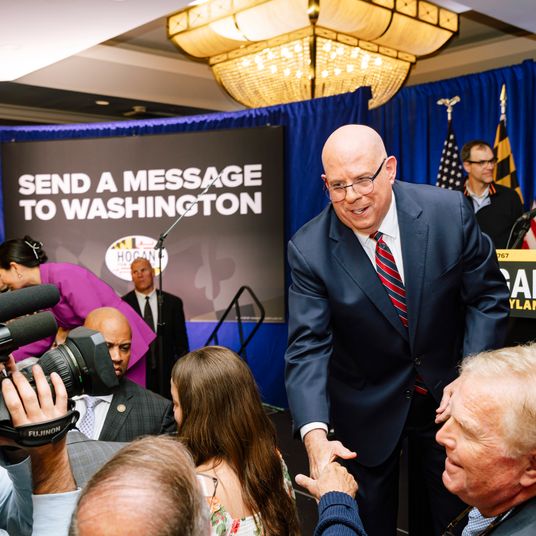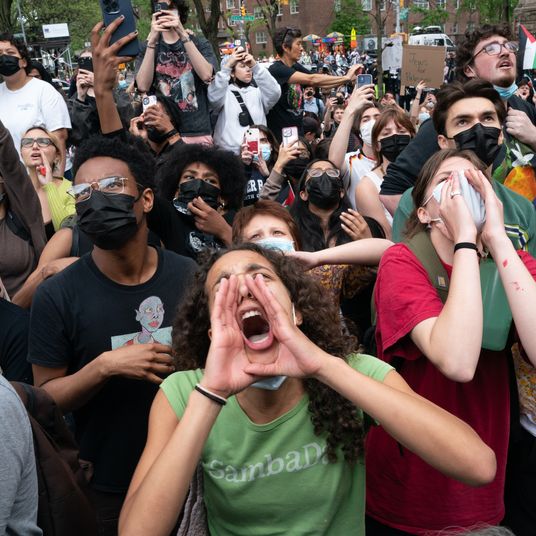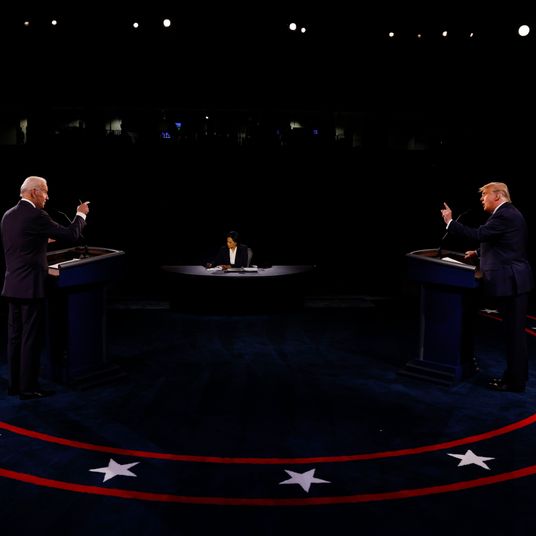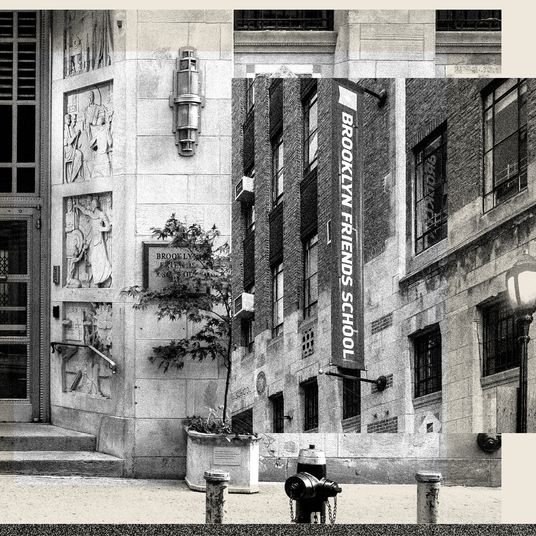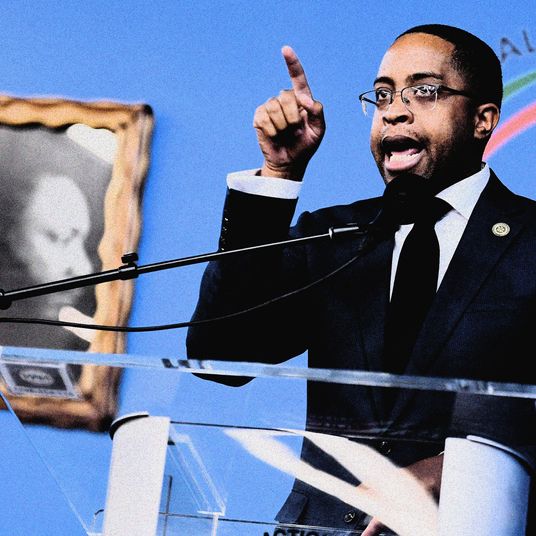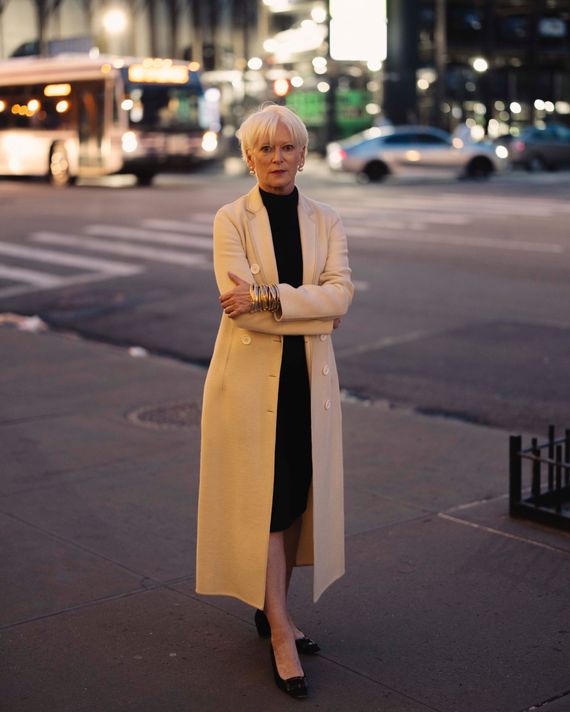
This article was featured in One Great Story, New York’s reading recommendation newsletter. Sign up here to get it nightly.
The Daily Beast had another scoop. On her first week on the job as chief creative and content officer, Joanna Coles carried a tip into the newsroom: A friend told her that Barron Trump would attend NYU for college. She told a group of staff to write it up for a new gossip column she wanted, called “Beast Buzz.” After trying to confirm the story, the team came up empty, but Coles pressed them to publish. The task fell to Tracy Connor, the editor-in-chief who eschews her office for a simple desk among reporters and editors. As she wrote up the blind item without a byline, Coles said in a voice loud enough for all to hear: “We will see how it does. Let’s hope it’s true!”
Brought on to revitalize the publication, the former editor of Cosmopolitan is busy remaking the Beast in her own image: buzzy, glitzy, and unafraid of controversy. “I’m going to blow it up,” she said this past weekend at the White House Correspondents Dinner, where she was hunting for talent. “We’re going to be pirates.” Already, though, she is clashing with the hard-news scoop machine she is trying to operate, according to multiple staff members, who spoke on the condition of anonymity to protect them from retaliation for speaking out. By the end of her first week, at least a dozen staff were looking elsewhere for jobs or hoping for buyouts, and by the end of her second, two were on the way out. For those who remain, fear of layoffs is widespread and morale is so low that some have been crying behind closed doors.
The speed of the takeover caused whiplash. On Monday morning, April 15, Barry Diller’s IAC announced a partnership with Coles and Ben Sherwood: IAC would retain a majority stake while the two media veterans bought the rest for an undisclosed amount and were made salaried employees. Coles was placed in charge of the Beast’s editorial operations and Sherwood, the former chief of Disney and ABC’s combined television units, was made chief executive and publisher. “These are tough times for digital journalism, but the combined experience, expertise and energy of Ben and Joanna have made me an optimist about their ability to make The Beast an enduring and successful enterprise,” Diller said in a statement. (A spokesperson told me IAC is investing in the Beast for its next chapter.) A knowledgable observer agrees, saying “they will be great for the Beast in the long run if they don’t fuck up the transition.”
That afternoon, the staff rushed to IAC’s headquarters, a swooping, Frank Gehry building overlooking the Hudson. It was the fullest the office had been since before the pandemic. Just after 2 p.m., Coles snatched a microphone and breezed through her considerable résumé before announcing two new jobs that would show what sort of stories she wanted to prioritize. Effective immediately, she would hire a Chief Lauren Sanchez Correspondent and a Chief Fruits and Vegetables Correspondent, based in Montecito, California, to cover Meghan Markle’s American Riviera Orchard, which she was “completely obsessed” with. (The Beast would later publish six stories on Markle’s jam in as many days.) “They were coming in here to install some warped vision of the Daily Beast that is not what we do,” said a Daily Beast staffer of several years. “Her version of news is trend pieces and listicles.” Sherwood followed up by telling the staff, which totals about 100 including the business side, that they would work harder than ever. “On their first day, they delivered their speech and they lost the newsroom almost immediately,” the staffer continued.
By the end of the meeting, where the editor-in-chief was seated in the crowd and did not speak, the staff had only a vague notion of what their bosses would do or who was even in charge. “If I survive and stay, do I work for the editor-in-chief or Joanna?” one staffer said. “Everyone who grew up in a newsroom is confused by what a creative director does.”
“We have been candid with the staff about the need for us to take time to assess the business,” Sherwood and Coles said in a joint statement, after declining an interview request. “It’s been less than 3 weeks and we are coming up with a thoughtful plan for The Daily Beast’s future. Change is always hard, especially in these challenging times in digital media. One thing is for certain: we are committed to making The Beast one of the most formidable digital news and opinion platforms in the industry.”
The newsroom was also confused by the Sanchez job, which Coles made public the next day by posting it online. “No one since Brooke Astor has dominated the American social landscape faster than Ms Sanchez with her aviation skills, philanthropy and fabulosity,” she wrote on Instagram, adding that Sanchez is “intelligent,” “gorgeous,” and “funny” in comments to the New York Post, which wrote up her first big move as boss. Coles advertised a salary of up to $200,000 for a reporter to cover one person. When Sherwood asked staffers what they thought of the splash Coles made, one asked him if the job was real. “She got a full page ad in the Post,” he answered.
Three days later, in a bargaining meeting with the Beast union, the company said the job posting was fake, according to Kari Bienias, the union’s local representative with the News Guild of New York. “That is not a real position,” she said. “As far as current management is aware, that is not a real job posting.” Union members were told it was a “joke meant to generate buzz,” according to a person familiar with the meeting. The company hasn’t posted either correspondent position, more than two weeks after Coles announced the jobs.
The staff also questioned why their boss was also publicly defending Sanchez, the fiancée of billionaire and Amazon chairman Jeff Bezos, in a tiff with Keith McNally, the restaurateur, who called her “absolutely revolting.” “It’s not a great look for a publication that prides itself on holding power to account to fawn over a billionaire’s fiancée,” remarked one staffer. Last year, Coles signed a deal with Amazon Studios to produce a streaming show starring Priyanka Chopra.
Though Coles has the title of chief content officer, she assigns like a magazine veteran. Michael Wolff, her former colleague at New York, once described her as the ideal editor, “with her heightened gossip radar, cutting sense of social detail, and fine sense of who’s up and who’s down.” True to form, she recently assigned another un-bylined story about “The Look-Alike Women in Donald Trump’s Orbit” focusing on “head-turning brunettes of a certain stripe.” It’s not always clear which ideas Coles wants to pursue and which she is just throwing out, according to one person. For example, according to another staffer, Coles proposed a list of “the five most obese members of Congress.” The piece wasn’t assigned.
She did assign two other stories that made editors scramble to kill them for fear of embarrassment. One was to follow up on a rumor that Donald Trump passed gas in his criminal trial. She assigned the politics team to reach out to gastroenterologists about whether the emissions were “stress farts or sleep farts.” Another was assigned with the headline “Is Protesting the New Sex for Gen Z?” making the case that the campus protests across the country were largely being done for a thrill rather than true concern for Palestinian or Israeli lives. Several people warned against publishing a story they viewed as both insensitive and inaccurate.
When Matt Fuller, the Washington bureau chief and top politics editor who was leaving for a new job, pushed back on another protest-related idea of Coles’s — she wanted to report out who was paying for the tents in the encampments and find out whether there was an “Astroturf” element to the protests — he was told to leave a week early.
The staff is divided into roughly two camps: those who want out immediately regardless of the challenges and those hoping to adjust to the new regime. For those in the former category, their position is complicated by the fact that finding a new job is harder to do after the past year of massive media layoffs and shuttered publications.
“The big question is, what’s going to happen to the journalism?” said one Daily Beast veteran. “Everybody that’s ever worked for the Daily Beast is down to do the news with a sense of fun and a subversive feeling. Those people are also stone-cold reporters and that’s what they love to do, and that’s what has differentiated the Beast.”
The fundamentals of the media industry have also changed drastically since Coles left Hearst in 2018 after being passed over for president. Beginning as an aggressive reporter on Fleet Street, she came to the United States and rose up through the magazine world in the final years of plenty. For decades she has been measured up against fellow Brits Anna Wintour and Tina Brown. At 61, Coles is about a decade younger than either woman and caught only the tail end of the era when top editors at major titles had virtually unlimited resources and internal authority. But Daily Beast staff noticed some lingering mannerisms of that period. During her first week in the office, she asked if a reporter or intern could follow her around to take notes on what she’s thinking. She is now hiring for a chief of staff.
Coles did not have to tangle with a union when she was at Hearst, either. Though the Beast union’s contract expired at the end of 2023, the agreement remains in force and that means any layoff without a new contract would be illegal, according to Bienias. Even with a new contract, the union would negotiate over any proposed staff cuts. “We intend to protect members to the fullest extent possible, by law and otherwise,” Bienias said.
Like many media figures, she is also a multi-hyphenate entrepreneur: starring in a reality-TV show called So Cosmo and creating another semi-autobiographical show called The Bold Type. She even found time to write a book about finding love in the digital age. Coles joined the SPAC craze a few years back, taking the dog-product company BarkBox public on the New York Stock Exchange. She’s also been a member of Snapchat’s board since 2015 and sat at the company’s table at this year’s White House Correspondents Dinner, opting not to sit at the Beast’s.
Coles and Sherwood had designs on their own publication in 2019 when, fresh out of their jobs at Hearst and ABC, they collaborated on Project Scoop, a digital-media venture, according to the New York Times. By that time, the Daily Beast had shaken off the failed $100 million merger with Newsweek to become a scrappy tabloid, breaking story after story out of Trump’s scandal-a-minute Washington. (I worked as an editor at the Daily Beast for six years, leaving in 2019.) Despite strong traffic and a growing subscription base, the Beast had the same problem as ever: It always lost money, according to people with knowledge of its finances.
Diller, though, tolerated the losses because of what has been described as a sentimental attachment to the website he founded with Tina Brown in 2008. His executives weren’t so keen. “IAC was proud to have it, but as a business, these guys wanted to make money at everything,” said one former member of the company. Another was more blunt: “Nobody cares about it at IAC but him.” Diller was personally involved in high-level decision-making, such as finding a successor for editor-in-chief Noah Shachtman, who left for Rolling Stone in 2021. “I’m always most pleased to promote from within, and Tracy Connor is a fine example of that preference: talented, savvy, and more than capable of leading the Beast,” he told the Times in a story about her ascension.
By 2022, however, his mood had darkened. Diller expressed dissatisfaction about the site’s “woke” turn and an emphasis on lurid crime stories. By the end of the year he was contemplating a new editor. At the same time, the advertising business was in decline and IAC executives implored Diller to sell the money-losing publication. In the new year, he explored a sale, with potential buyers including Jeff Zucker and Slate. A merger proposal between Diller and Ankler co-founder Janice Min fell apart last summer. “The Daily Beast is not for sale,” he told the Times after the talks ended.
Coles and Sherwood had previously “circled” the Beast, according to one person familiar with the sales effort, but had not spoken formally to Diller. That changed several months ago when a banker reached out to them, according to the Times, and they pitched him on a partnership with a new vision for the Beast. “On the business side, he wanted someone who wasn’t interested in not losing money, but actually making money, who could squeeze every drop out of every corner,” said one person familiar with Diller’s thinking. “On the edit side, he wanted someone with vision, big ideas, thinking outside the box, who was outrageous.”
“He’s looking to make a splash and build a business,” as another person put it succinctly.
Diller turned 82 earlier this year, and it’s apparent to all that the Beast would be in immediate danger without him as IAC’s chairman. Joanna Coles and Ben Sherwood are his way of “protecting the Beast and giving it a future beyond him,” said the person familiar with his thinking. “Barry does, big picture, care about the Daily Beast.”






